Mastering Mice Pest Control: The Power of Snap Traps
At Apex Pest Control, we understand the importance of effective and efficient rodent control. Our expertise in pest management across Sheffield, Barnsley, Rotherham, and South Yorkshire has taught us that snap traps are one of the most powerful tools in the fight against mice infestations. In this comprehensive guide, we’ll explore the world of snap traps, their effectiveness, and how to use them properly for optimal results.
Discover the most effective rodenticides and mice poisons with our expert guide, covering top solutions and strategies for safe and efficient rodent control.
What Are Snap Traps?
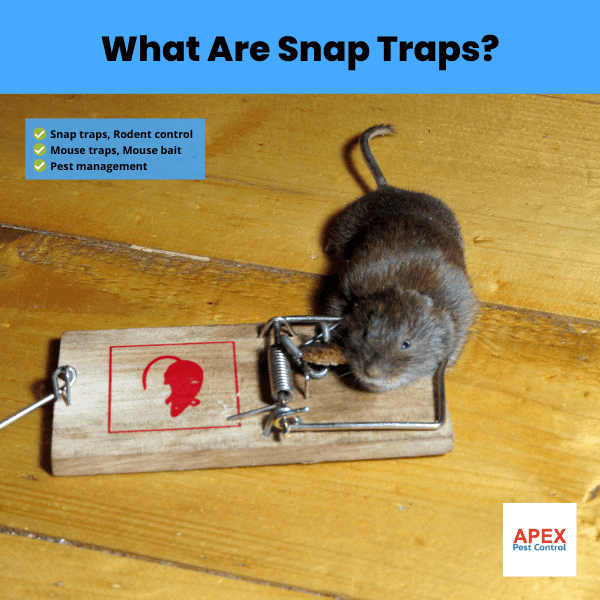
Snap traps are a traditional and widely used method for rodent control. These devices consist of a spring-loaded metal bar or wire that’s triggered when a mouse disturbs a pressure-sensitive plate. Once activated, the trap swiftly closes, either trapping or instantly killing the rodent.
Types of Snap Traps
There are several types of snap traps available on the market:
| Type | Pros | Cons |
|---|---|---|
| Wooden | – Inexpensive – Biodegradable – Traditional and familiar |
– Can warp in humid conditions – May absorb odours – Less durable than other materials |
| Plastic | – Easy to clean – Durable – Often reusable |
– May crack in extreme temperatures – Can be chewed by rodents – More expensive than wooden traps |
| Metal | – Extremely durable – Resistant to gnawing – Long-lasting |
– More expensive – Can rust if not properly maintained – Heavier and less portable |
How Snap Traps Work
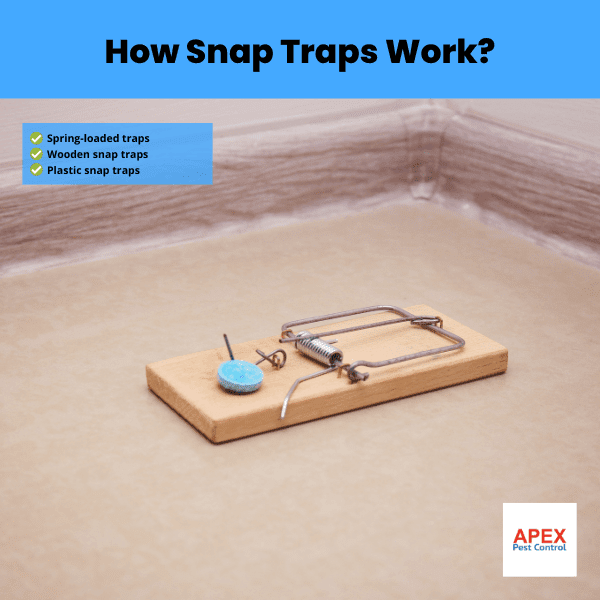
Snap traps operate on a simple yet effective mechanism. When a mouse attempts to retrieve the bait placed on the trigger plate, the slightest pressure activates the spring, causing the strike bar to snap shut with considerable force. This swift action is designed to either trap or deliver a fatal blow to the rodent instantly.
The Importance of Proper Placement
For optimal effectiveness, it’s crucial to place snap traps strategically. Mice tend to travel along walls and in corners, so positioning traps perpendicular to walls with the trigger end touching the wall is ideal. Here’s a simple guide for proper trap placement:
- Place traps perpendicular to walls with the trigger end touching the wall
- Set traps in pairs, about 2-3 feet apart
- Position traps in dark corners and behind furniture
- Place traps along known rodent runways
The Effectiveness of Snap Traps
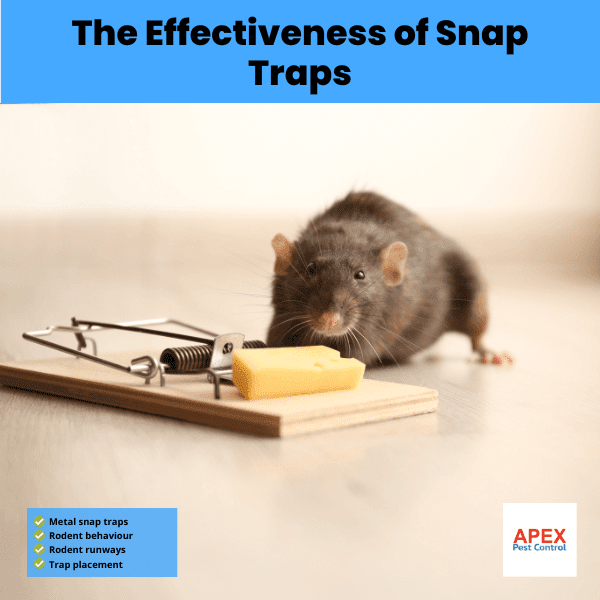
Snap traps have stood the test of time as an effective rodent control method. According to a study published in the Journal of Urban Ecology:
- Snap traps have a success rate of 88% in capturing rodents when properly placed and baited.
- Multiple snap traps used together can increase capture rates by up to 35% compared to single traps.
- Wooden snap traps were found to be 27% more effective than plastic traps in field tests.
Dr. Robert Corrigan, urban rodentologist, states: “The key to successful snap trapping is understanding rodent behaviour. Place traps where rodents travel, not where humans think they should go.”
Baiting Strategies for Snap Traps
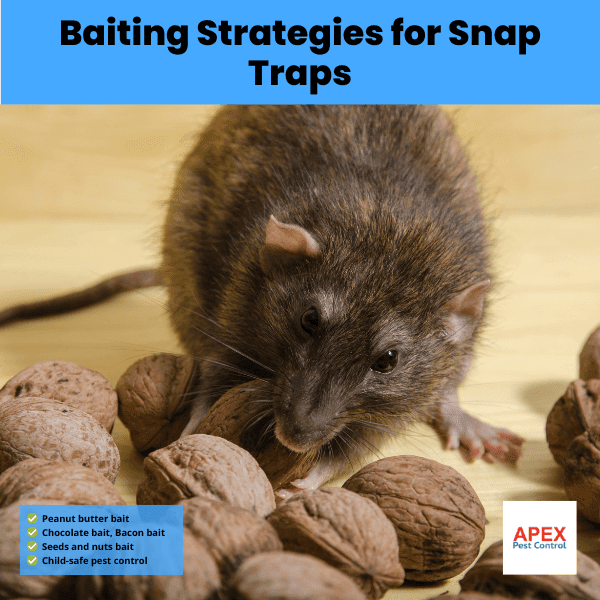
Choosing the right bait is crucial for the success of your snap traps. Contrary to popular belief, cheese is not the most effective bait. Here are some expert-recommended baiting strategies:
- Peanut butter: Its strong smell and sticky consistency make it an excellent choice.
- Chocolate: The sweet aroma is highly attractive to mice
- Bacon: The strong scent can lure mice from a distance.
- Seeds or nuts: These mimic the natural food sources of mice.
Pros and Cons of Using Snap Traps
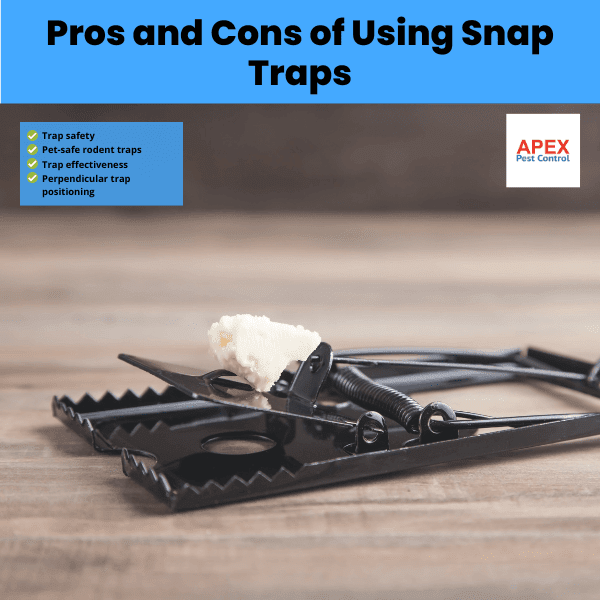
Pros:
- Cost-effective
- Reusable
- Quick kill (when properly set)
- No chemicals involved
Cons:
- Can be messy
- Potential for injury, if not lethal
- May scare other rodents
- Requires frequent checking
Safety Considerations
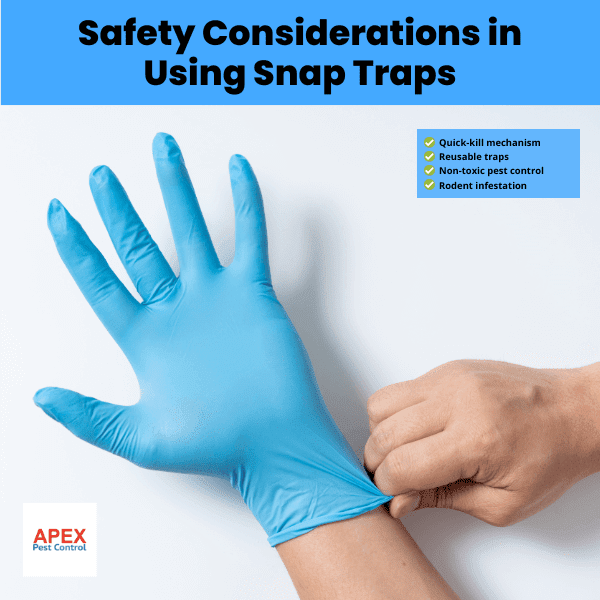
While snap traps are effective, it’s important to use them safely.
- Keep traps out of reach of children and pets
- Wear gloves when handling traps and disposing of rodents
- Clean and disinfect the area after removing a trapped rodent
- Dispose of dead rodents properly in sealed plastic bags
Alternatives to Snap Traps
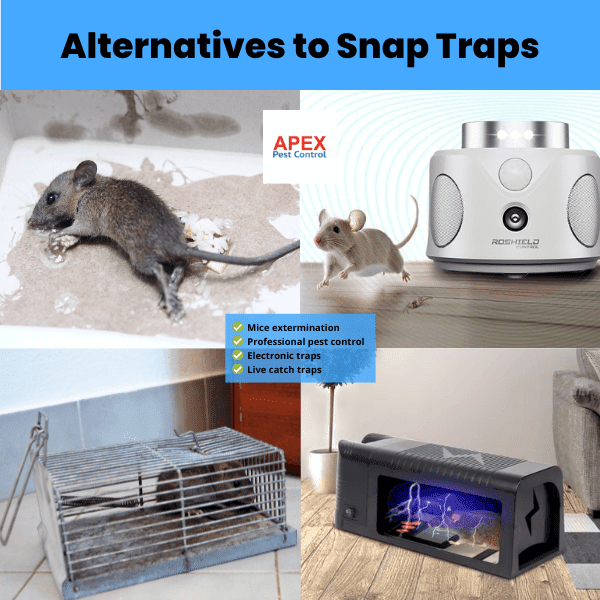
While snap traps are highly effective, there are other methods of rodent control that may be suitable in certain situations:
- Electronic traps: These deliver a quick, lethal electric shock to rodents.
- Live catch traps: Ideal for those who prefer to release rodents alive.
- Ultrasonic repellents: These emit high-frequency sounds to deter rodents.
Environmental Considerations

At Apex Pest Control, we’re committed to environmentally responsible pest management. Snap traps offer several eco-friendly benefits:
- No chemical use, reducing environmental impact
- Targeted approach, minimising harm to non-target species
- Reusable design, reducing waste
Common Mistakes to Avoid
To ensure the effectiveness of your snap traps, avoid these common pitfalls:
- Using too much bait
- Improper placement
- Not checking traps regularly
- Using dirty or old traps
Professional Pest Control Services

While snap traps can be effective for small-scale infestations, larger or persistent rodent problems may require professional intervention. At Apex Pest Control, we offer comprehensive rodent control services across Sheffield, Barnsley, Rotherham, and South Yorkshire. Our expert technicians use a combination of methods, including snap traps, to ensure your home or business remains rodent-free.
Frequently Asked Questions
How long does it take for snap traps to work?
Snap traps can work immediately, but it may take several days to see results. Rodents are often cautious of new objects in their environment. Be patient and check traps daily, replacing bait as needed.
How many snap traps should I use?
For effective control, use multiple traps. A good rule of thumb is to place traps every 2-3 feet along walls where you’ve seen rodent activity. For mice, you may need 6–12 traps for an average-sized room.
Are snap traps humane?
When properly set, snap traps can provide a quick death for rodents. However, there is a risk of injury if the trap doesn’t kill instantly. For those concerned about humane methods, consider live catch traps as an alternative.
What’s the best bait for snap traps?
Peanut butter is often considered the best bait due to its strong smell and sticky consistency. Other effective options include chocolate, bacon, or nuts. The key is to use a small amount to encourage the rodent to interact with the trigger.
Where is the best place to put snap traps?
Place snap traps perpendicular to walls with the trigger end touching the wall. Rodents tend to travel along walls and in corners. Other good locations include behind appliances, in dark corners, and near food sources.
How do I dispose of a mouse caught in a snap trap?
Wear gloves and place the mouse in a sealed plastic bag. Dispose of it in an outdoor bin. Clean and disinfect the area where the mouse was found, as well as the trap if you plan to reuse it.
Can snap traps harm pets or children?
Yes, snap traps can potentially harm pets or children if they come into contact with them. Always place traps in areas that are inaccessible to pets and children, or consider using enclosed traps designed with safety in mind.
By following these guidelines and using snap traps effectively, you can significantly reduce rodent populations in your home or business. Remember, for persistent or large-scale infestations, it’s always best to consult with professional pest control experts like Apex Pest Control. We’re here to ensure your property in Sheffield, Barnsley, Rotherham, or anywhere in South Yorkshire remains pest-free.

Tony Johnson, Founder & Lead Technician at Apex Pest Control, is a BPCA and NPTA accredited pest management expert with over 35 years’ hands-on experience. Tony specialises in Integrated Pest Management and ensures all services comply with UK pest legislation, including the Wildlife and Countryside Act 1981 and COSHH Regulations 2002. His commitment to continual learning and adapting to industry best practices means clients receive effective, safe solutions for pests affecting homes and businesses across South Yorkshire. Tony’s dedication to professional standards, ethical treatment methods, and local expertise has made him a trusted partner for pest control and prevention.
-
BPCA & NPTA accredited | CHAS certified
-
Committed to UK pest law compliance & safety
-
Focused on effective, ethical pest management for South Yorkshire


